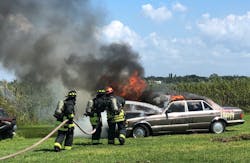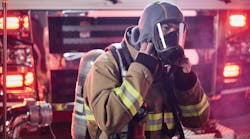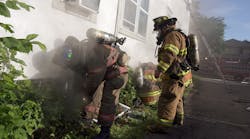As one of the busiest departments in the country, St. Petersburg Fire Rescue in Florida has committed resources to elevate the protection of their firefighters at the fire scene. For two years the department’s Safety and Training Division has been researching health and wellness issues as the industry continues to publish studies about fireground contaminants. It has focused its first efforts on upgrading fireground protocols and turnout gear, specifically related to hoods.
A member of the Safety and Training Division, Lieutenant Robert Neuberger, says, “Several firefighters in our area have needed aggressive treatment for neck and throat cancer, so this has been an important issue for our department. Our unit decided we needed to upgrade the department-issued hoods to NFPA-certified particulate hoods to provide better protection against fireground particulates.” The group evaluated various particulate hoods on the market and set the requirements for a hood that provided the highest level of certified protection after being washed repeatedly using the NFPA laundering protocols.
The Safety and Training Division ran a wear trial during which firefighters from the two busiest stations evaluated the hood for more than 60 hours, which included responding to structural fire and hazmat calls. They had two important reasons for the wear trial. First, they wanted to ensure that the hood performed well in real fireground conditions. Second, and just as important, they wanted to make sure that the firefighters liked the particulate hood; the firefighters that evaluated the new hoods have been in the service for many years, so this would be a change for them. According to Neuberger, the firefighters’ feedback was very positive, saying, “The GORE Particulate Hood was comfortable, and it provided better protection. It fit around the neck and the longer length stayed tucked in. They really liked the combination of the inspection opening and the red stitching that was only on the outside. The stitching helps them be sure they have the right side out after using the inspection opening to visually check the particulate-blocking barrier for cuts, tears, or holes.” So, based on this feedback, St. Petersburg purchased 400 GORE Particulate Hoods.
The Safety and Training Division talked with their MES dealer, John Schmidt, about decontamination protocols. As a retired firefighter, John had been doing his own research, and he had been developing protocols at his department before he retired. St. Petersburg has just ordered an additional 400 hoods so that each firefighter can swap out his or her hood during rehab at the fire scene. Neuberger explains, “It doesn’t make sense for us to stress wearing a clean hood for every call if they don a filthy hood when they return to the scene after rehab. Once we receive the additional hoods, our protocol will require all firefighters to don a fresh hood after rehab to help avoid contaminating their neck and face if they were to pull on a dirty hood.”
When asked about dealing with the increased costs of this program, Lieutenant Neuberger said the Safety and Training Division faced this potential issue directly. “We justified the investment by researching the total cost of our health and wellness programs, including health insurance and the impact of sick days. We also considered the importance of the morale of our firefighters. If they know we are looking out for their health and welfare by providing the best possible gear, then that has a positive effect on their morale. This can go a long way when they are hearing a lot about the health issues of fireground particulates.”
For more information about the St. Petersburg program, contact Lt. Robert Neuberger at [email protected].
About St. Petersburg Fire Rescue
With a force of 342 firefighters and paramedics, St. Petersburg Fire Rescue, Florida, has 32 pieces of firefighting apparatus, 14 fire stations, and an administrative building. The department provides specialized life safety services by staffing three specialty teams. The technical rescue team responds to elevated, below-grade, confined-space, and structural collapse rescues. The hazardous materials team handles spills and releases of toxic substances, liquids, or gases countywide. Staffed by certified rescue divers, the dive and marine rescue team responds to victim emergencies on St. Petersburg's many waterways. St. Petersburg Fire Rescue protects the lives and property of over 260,000 residents and responds to over 63,958 emergency incidents annually.
For more information about Gore hoods, visit https://www.goreprotectivefabrics.com/fire/sff/hoods/particulate-hood







